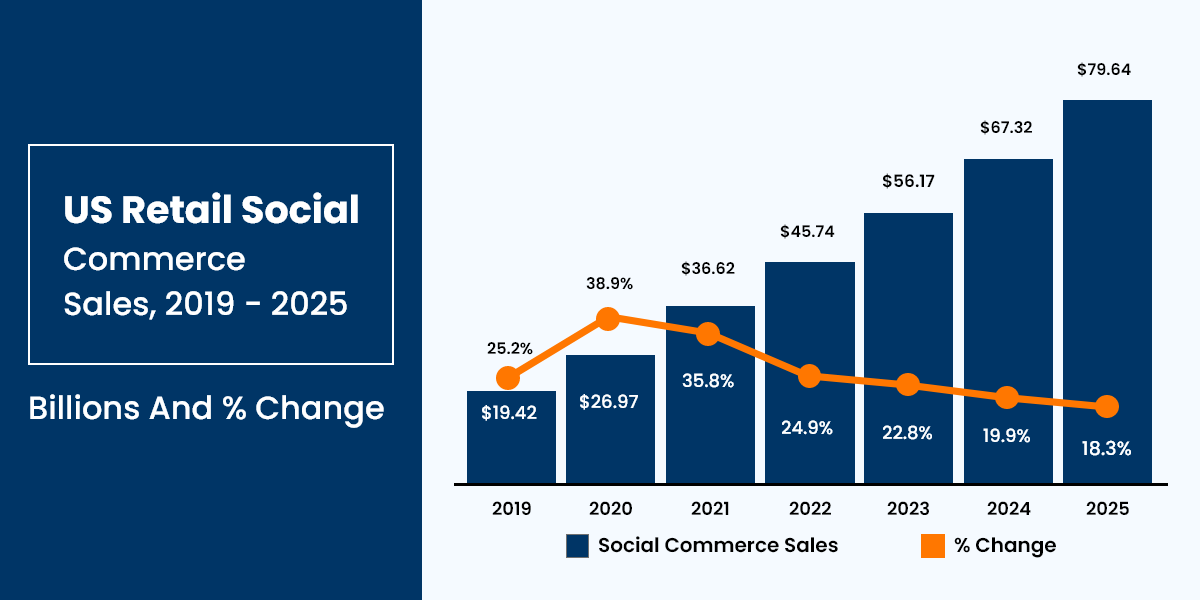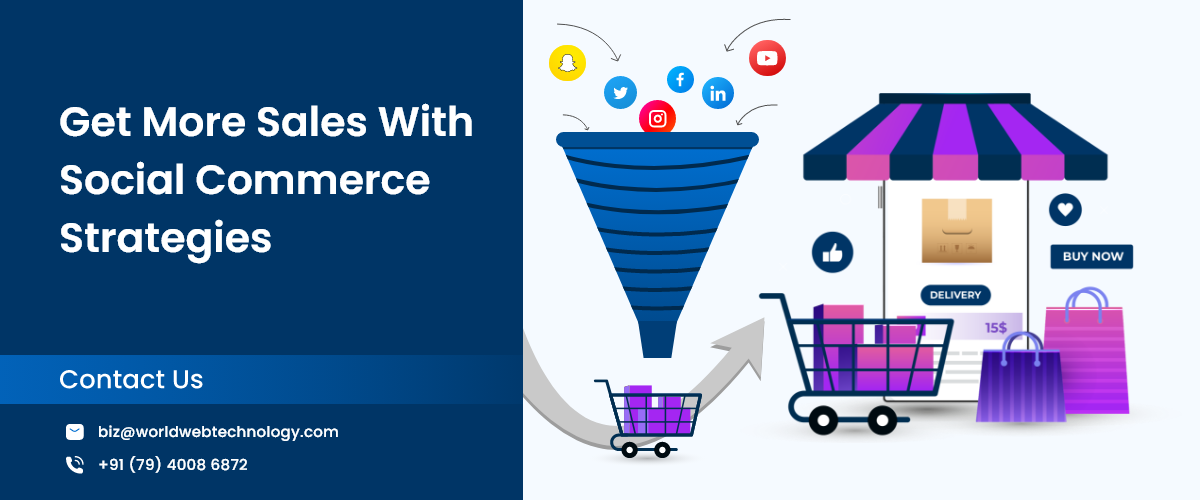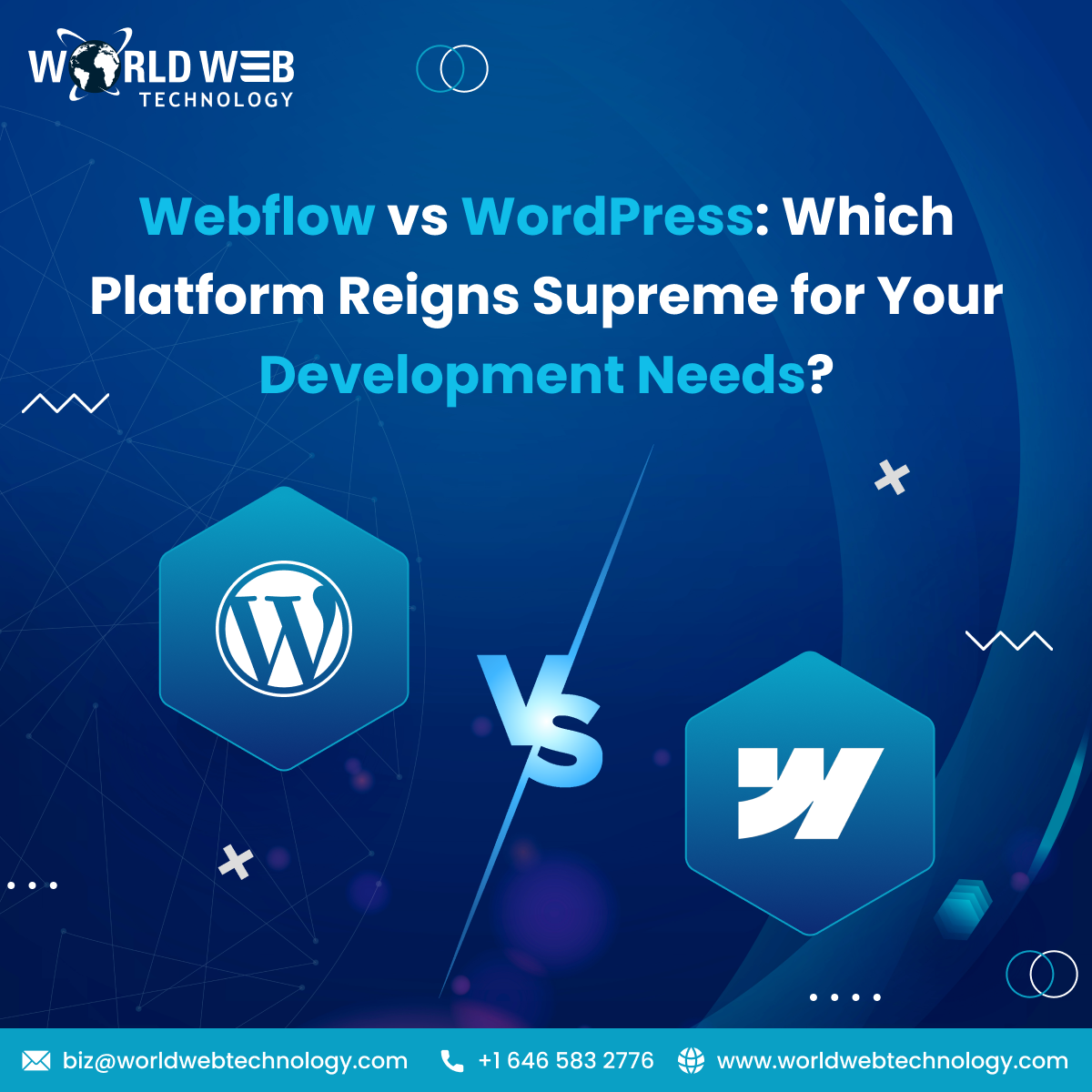Social Commerce Trends, For Your Business Growth
Businesses can sell their products direct to customers via social media platforms. Using social commerce, brands empowered themselves by providing a powerful tool for customers to buy wanted products without going to another website.
Category : E-Commerce
- Posted by : World Web Technology

Table of contents
- 01 What Led Social Commerce Become Hot Top in Business Arena?
- 02 Social Commerce Trends from Market Perspective
- 03 What is Social Commerce?
- 04 Why Social Commerce?
- 05 Social Commerce vs eCommerce: What Is The Difference?
- 06 Social Commerce 2025 Trends
- 07 Final Thoughts
- 08 About Author
- 09 Rate This Blog
Businesses can sell their products directly to customers beyond boundaries via social media platforms. Using social commerce, brands empowered themselves by providing an easy yet powerful tool for their customers to buy desired products without getting transferred to another link. Social Commerce Trend is now a core business strategy that every retailer keeps in mind. You might have many questions related to Social commerce in 2025 trends. So, we have sorted it out by providing the top social commerce trends to look at this year and beyond. Let’s explore;
Did you know 41% of customers say they shop daily or weekly using smartphones, while the percentage was just 12% 5 years ago?
Isn’t it a dramatic shift in the way we shop, especially in the last few years?
Yes. As smartphone shopping is at a historic high, social commerce is witnessing a significant boom. The COVID-19 pandemic came up with massive destruction to both lives and livelihood, but it taught a great many things to people, like maintaining social distancing and staying away from crowded places; this, in turn, helped people adopt digital platforms to do away with their daily everyday needs.
For example;
- They get their daily groceries delivered at home
- They buy desired products without stepping out of home
Social Commerce is one of the parts of these digital platforms where people do not need to download any shopping app, and instead, they can buy things while exploring Facebook or other social media channels. With effective social commerce market strategies, businesses can make the most out of tracking the trends.
So, we have introduced some of the top social commerce 2025 trends that are predicted to be appealing, especially for startups and entrepreneurs who want to keep their business thriving without investing serious bucks behind building dedicated eCommerce applications for their business.
What Led Social Commerce Become Hot Top in Business Arena?
As people are growing tech-savvy, they look for things that provide ease, comfortable and convenient services. Social media has all that, leading social commerce to mushroom, resulting in a paradigm shift across the industries. People using the social commerce platform could buy their preferred stuff after getting trusted feedback from other customers. from the comfort of their homes; they experienced it as a safer way of shopping that saves them precious time, money, and unnecessary effort.
What is Social Commerce?
A Social Commerce is the process of purchasing and selling products and services using social media platforms. Social Media platforms like Facebook, Instagram, Pinterest, and others are not just great sources of branding, but they can be the best medium to sell products by creating effective Social commerce marketing strategies. Social commerce also involves the sales of products and services promoted on social media linked to a stand-alone eCommerce website.
Examples Of Social Commerce Platforms
These are some of the popular Social Commerce platforms-
- Facebook Shops
- Instagram Shops
- Pinterest Shopping
- YouTube Shopping
- Snapchat Filters & Screenshop
Why Social Commerce?
When it comes to the importance of Social Commerce, it’s endless. The location is an essential element of Social Commerce as it leverages the pluses of social proof. Furthermore, it has the benefits of influencer marketing where you can approach influencers to promote your products across social channels.
Let’s have a look at some more pluses of Social Commerce!
- Social Commerce is a fast-growing trend
- Provides precise audience targeting
- Strengthens engagement between buyers and brands
- Helps to enhance sales
- Facilitates a frictionless shopping experience
Social Commerce vs eCommerce: What Is The Difference?
When it comes to separating the two online commerce, social commerce, and eCommerce, there is no considerable difference, and both are similar up to a large extent. You can think of social commerce as a part of eCommerce. But there is a slight difference- eCommerce happens using a website on your online store; on the other hand, Social Commerce takes place on social media.
You can sometimes expand the meaning of Social Commerce to include all the sales performed using social media. As a widened definition, sales made through social media ads will come under Social Commerce. If the link of your online store is given in the ad and a customer follows that, it too will come under Social Commerce.
Social Commerce 2025 Trends
Did you know US social commerce is all set to become a $45.74 billion market in 2022?
As people, especially Generation Z and Generation Alpha are growing more tech-savvy, Social commerce is poised to become a key driver of business growth. In the next few years, it will overtake traditional commerce. People like to buy things that inspire them —turning their inspiration into a purchase. The US market is already making a big earning through Social Commerce and the data given here is the testimony.

According to a report by Accenture, social commerce is going to be a $1.2 trillion market in 2025, more than double that in 2021 with $492 billion.
So, we have discussed different important factors of Social Commerce, let’s jump to the core parts, ” Social Commerce Trends for 2025.
- Visual Shopfronts On Instagram
- Frictionless Experience Enhances The Loyalty
- 5G Connectivity For Customer Experience
- Digital Avatars in Fashion Industry
- Micro-Influencers Boost Brand Reach
- User-Generated Content Works as a Marketing Strategy
- Voice Technology and Conversational Shopping
- Low-Priced Products Optimize The Sales
- Use of NFTs (non-fungible tokens)
- Increased use of AI, ML, and AR
Let’s explore them one by one.
Visual Shopfronts On Instagram
Users, especially Gen Z and Generation Alpha are making effort to adore things that inspire them. Instagram has initiated Visual Shopfronts where users can buy products from pictures and videos without leaving space. That means they do need to get redirected to any app to buy the product.
For example, while exploring new feed, reels, or images, or videos, they can tap on the tagged products and explore descriptions. Even they can buy products from the very page.
Smooth Sopping Experience Results Branding and Better Loyalty
In this era of technology, where people are accustomed to getting fast solutions, they can’t tolerate even a slight inconvenience. Hence, brands require to offer a frictionless shopping experience to users. Delivering a quick and convenient experience can be one of the crucial to enhancing trust, branding, and selling.
Brands using complex and outdated business models with a complex buyer’s journey are more likely to exasperate their customers. On the other hand, a business providing its customers with a frictionless and streamlined experience across multiple platforms has more chances to enhance its retention rate with the optimized acquisition.
To offer your customers a frictionless experience, explore your customers’ experience map, find out the blockage, and fix them. Aiming to streamline the process, remove the steps that are no longer useful and make it convenient for the customers to perform purchasing hassle-free. Keep improving the customers’ experience until or unless you succeed in meeting what they are looking for.
Faster and Reliable Shopping Experience 5G Connectivity
A report from eMarketer anticipates growing AR users in the U.S to101.6 million in 2023 from 83.7 million in 2020. It’s massive, isn’t it?
With the global deployment of 5G wireless connectivity, brands will be able to provide a seamless mixed reality experience across multiple connected devices. By doing so, businesses can enhance their customers’ experience conveniently.
To provide customers with an immersive experience, brands only have to do is to leverage the advantages of 5G. If they are able to do so, they can surpass their expectation of optimizing the customers’ experience of social commerce.
Digital Avatars will be Game Changer
Using digital avatars in the fashion industry will be one of the Social Commerce Trends 2025. Undoubtedly, the influencers will still be the brand ambassadors to play a predominant role in promoting jewelry and clothing. Still, digital avatars will be the primary model in digital fashion runways.
The digital avatars will offer flexibility to brands for different purposes, including promoting launches, digital sampling, layering digital clothing, and so on. It provides customers with numerous alternatives and enables them to get a realistic view of how the clothes and accessories fit them while shopping online. The process helps customers conduct immediate purchases.
Furthermore, the rapid rise of the Metaverse will accelerate the usability of digital avatars in 2025. By using this trend, fashion retailers will be able to offer digital clothing used by these avatars.
Micro-Influencers will be Credible Marketing Source
Although it isn’t a new trend in the market, collaboration with micro-influencers is and will be relevant in 2025 too. Micro-influencers will assist brands, especially small businesses, to reach their audience widely by enabling them to balance the ad budget. Micro-influencers are the best alternative for brands to widely reach their audiences on a simplified budget, hence being affordable and productive.
The Micro-influencers are more affordable than big influencers having hundreds and thousands of followers. They collaborate with brands under a reasonable and affordable budget, even for small enterprises. The micro-influencers have a specific and targeted audience that helps them simplify the ad targeting and segmentation. Besides that, they’re considered more reliable and transparent about paid collaboration than the big influencers.
With all the facts mentioned earlier in this article, micro-influencers are the best bet for helping brands in driving conversions. Furthermore, they’re transparent, approachable, and authentic compared to big influencers having a wide array of followers.
User-Generated Content will Boost Purchases
User-generated content is still of great importance for marketing strategy. Likes, comments, and sharing are the essence of people’s communication on social media platforms.
The user-generated content has proved advantageous for brands and will continue to be so in upcoming years. It enables your users to feel combined and working with the brand rather than just being treated as a targeted customer. This enhances the reach of social media campaigns, ensuring a better ROI on the same.
Besides these all, the user-generated content is competent enough to alter the altitude of people. The UGC is created by the people outside, and hence, It’s trustable.
Voice Technology and Conversational Shopping
Voice technology and conversational shopping are the key Social Commerce Trends 2025 that are becoming popular day in and day out. Gen Z and millennials prefer using voice search for any query as it feels more convenient than typing. People who use voice search for questions are more likely to buy stuff using the same technology.
As per a report from Statista, the searches using voice assistance will reach USD19.4 billion by 2025, from USD4.6 billion right now. Isn’t it a huge increase? This is even more than a quadruple increase in just two years. It’s also an immense market share that no brand wants to overlook.
Apple and Android both integrate voice technology into their devices, and these voice assistants are constantly becoming more sophisticated with each optimization. Stand-alone devices like Google Home, Amazon Alexa, and others are commonplace. Hence this is the right time for you to leverage the opportunity by optimizing your brand for the voice search capability.
Low-Priced Products Optimize The Sales
The low-priced products will remain more in demand compared to the expensive ones, just like the previous year. The reason might be a lack of trust, as customers are less likely to buy costly goods while browsing through social media platforms. They prefer buying cheaper products via Social Commerce, and for big-ticket items, they are more likely to explore profoundly and visit an in-person store to lessen the risks.
Social Commerce is still new to the market and feels risky up to some extent for the people who aren’t familiar with online purchasing. For instance, a person shopping using Social Commerce might purchase stuff worth $30 but feel it risky to buy a piece of jewelry made of gold or diamond. Hence, considering these facets, place your low-priced goods at the front to engage more customers.
Use of NFTs (non-fungible tokens)
With the increased popularity of Metaverse, the demand for NFTs marketplace (non-fungible tokens) is in the mainstream. Further, Facebook’s rebranding to meta has boosted its growth. NFTs power creators, artists, and small businesses similarly and will be one of the Social eCommerce Trends for 2025.
Before embarking on using NFTs for your brand, explore thoroughly and exercise due diligence to make sure NFTs could help you add long-term value to your brand. Several digital creators and artists consider it an innovative form of compensation for their work. However, causing an environmental impact, the lack of regulations, and its volatile nature have been a cause of criticism for NFTs.
Businesses engaged with social commerce and eCommerce must examine thread barely to know how NFTs are competent enough to benefit them in the emerging creative economy as well as in the digital ecosystem. NFTs can become power collectors, creators, and small brands similar to a new form of social commerce.
Increased use of AI, ML, and AR
Last but not least! This is the last Social Commerce trend 2025 in this article; albeit many out there to explore, they have great potential to keep your business thriving. Emerging technologies like AI (Artificial intelligence), AR (Augmented reality and ML (Machine learning) enable brands to elevate their social commerce game and get it to the next level. The AI makes chatbots usable and undertakes conversions with prospective buyers.
The best example of AR on social media is perhaps on Instagram, where people can alter and modify the on-screen looks of their surroundings. TikTok, too, has almost equal capabilities to assist you with your created videos. On the other hand, businesses have used AR to enable you to decorate your accommodation by adding new stuff with the use of a camera on your phone just from the confines of your home.
Final Thoughts
In early 2020, the global economy came across a tumultuous situation, but things changed soon. In 2021, brands started recognizing the rapidly growing popularity of social commerce and took all possible steps to level in with their eCommerce store. However, Social Commerce is still new to the market and a bit difficult for people who aren’t adapted to online shopping; these trends will certainly help you optimize your Social Commerce Marketing Strategies in 2025.
World Web Technology
World Web Technology is an India and USA-based Web Design, Web Development, and Mobile App Development Company that offers creative and proven web solutions around the globe.

Rate This Blog
Average 5 / 5. Rating 1
No votes so far! Be the first to rate this blog.
Most Popular Categories
Discover top categories on our blog, featuring WordPress, PHP, eCommerce, and Shopify insights and tutorials.
Featured Insights
Immerse yourself in our passion for sharing the latest industry news, cutting-edge technologies, and insightful articles. Explore the depths of knowledge with us.


















Social Commerce Trends from Market Perspective
It’s anticipated that the world of online shopping will continue reshaping itself In 2025, and social commerce will play a vital role. This is why we’ve come up with the Social Commerce 2025 Trends, that’ll assist you in reshaping your business to meet your customers’ demands. Stay tuned! You’ll be backed with top-notch social commerce ideas.